Nickname(s) "Hessian mercenaries" | ||
 | ||
Engagements American Revolutionary WarBattle of Long IslandLanding at Kip's BayBattle of Edgar's LaneBattle of White PlainsBattle of Fort WashingtonBattle of Fort LeeBattle of Iron Works HillBattle of TrentonForage WarBattle of Bound BrookBattle of Short HillsSiege of Fort TiconderogaBattle of HubbardtonSiege of Fort StanwixBattle of BenningtonBattle of Staten IslandBattle of Cooch's BridgeBattle of BrandywineBattle of the CloudsBattles of SaratogaBattle of GermantownBattle of Red BankBattle of GloucesterBattle of White MarshBattle of Barren HillBattle of MonmouthGreat Siege of GibraltarCapture of Fort ButeBattle of Baton RougeSiege of CharlestonBattle of Connecticut FarmsBattle of SpringfieldBattle of MobileSiege of PensacolaBattle of Spencer's OrdinaryBattle of Green SpringBattle of Groton HeightsSiege of YorktownBattle of JohnstownRaid on Lunenburg Notablecommanders Wilhelm von KnyphausenJohann Rall † | ||
Hessians /ˈhɛʃən/ is the term given to the 18th century German auxiliaries contracted for military service by the British government, which found it easier to borrow money to pay for their service than to recruit its own soldiers. They took their name from the German state of Hesse-Kassel. The British hired Hessian troops for combat duty in several eighteenth century conflicts, but they are most widely associated with combat operations in the American Revolutionary War (1775–1783).
Contents
- History
- American Revolutionary War
- Hessian captives
- Lancaster POW experience
- Nova Scotia theatre
- Conclusion of the war
- Commanding officers
- Units in the American Revolution
- Ireland 1798
- In popular culture
- References
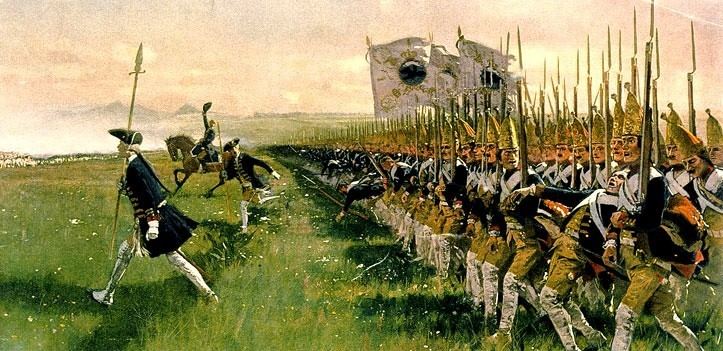
About 30,000 German soldiers fought for the British during the American Revolutionary War, making up a quarter of the troops the British sent to America. They entered the British service as entire units, fighting under their own German flags, commanded by their usual officers, and wearing their existing uniforms. The largest contingent came from the state of Hesse, which supplied about 40% of the German troops who fought for the British. The large number of troops from Hesse-Kassel led to the use of the term Hessians to refer to all German troops fighting on the British side, a form of synecdoche. The others were rented from other small German states.
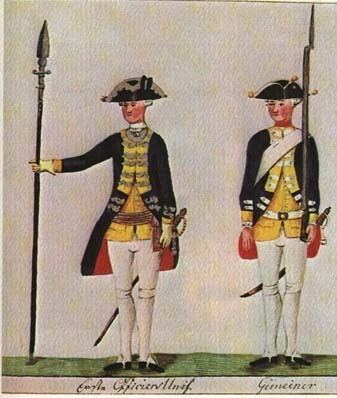
Patriots presented the soldiers as foreign mercenaries with no stake in America. Many of the men were press-ganged into Hessian service. Deserters were summarily executed or beaten by an entire company. Hessian prisoners of war were put to work on local farms.
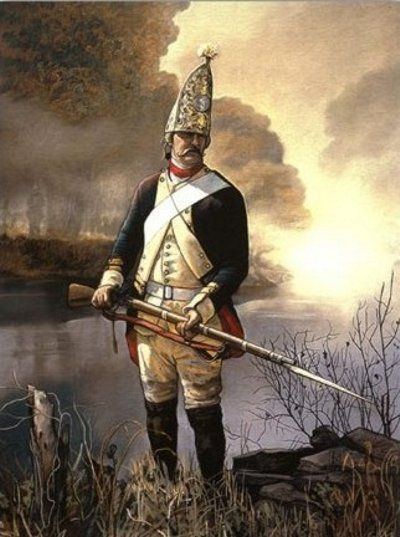
History
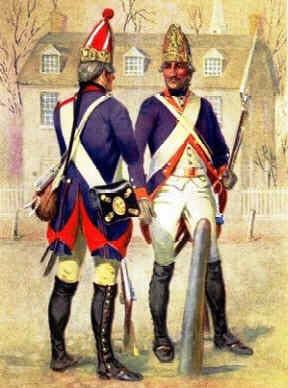
The small German states of the Holy Roman Empire had professional armies, which their ruling princes were sometimes willing to hire out for service with other armies as mercenaries. When military conflict broke out, the German states provided a ready supply of trained troops that was ready to go into action immediately. Hesse-Kassel was particularly prominent in this role:
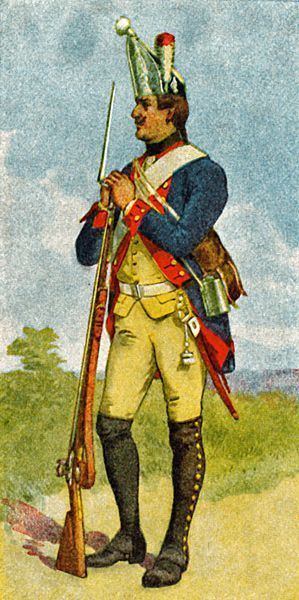
Between 1706 and 1707, 10,000 Hessians served as a corps in Eugene of Savoy's army in Italy before moving to the Spanish Netherlands in 1708. In 1714, 6,000 Hessians were rented to Sweden for its war with Russia whilst 12,000 Hessians were hired by George I of Great Britain in 1715 to combat the Jacobite Rebellion. ... In the midst of the War of the Austrian Succession in 1744, 6,000 Hessians were fighting with the British army in Flanders whilst another 6,000 were in the Bavarian army. By 1762, 24,000 Hessians were serving with Ferdinand of Brunswick's army in Germany.

In most of these wars, Hesse-Kassel never became a belligerent by declaring war on any other country. The troops were rented for service in other armies, and Hesse-Kassel itself had no stake in the outcome of the war. Thus, it was possible for Hessians to serve with the British and Bavarian armies in the War of the Austrian Succession, even though Britain and Bavaria were on opposite sides of the war. Historian Charles Ingrao says that the local prince had turned Hesse into a "mercenary state" by renting out his regiments to fund his government.
American Revolutionary War

During the American Revolutionary War, Landgrave Frederick II of Hesse-Kassel and other German princes hired out some of their regular army units to Great Britain for use to fight against the rebels in the American revolution. Of 30,067 German troops leased by Great Britain, 12,992 were supplied by Hesse-Kassel. They came not as individuals but in entire units with their usual uniforms, flags, equipment, and officers.
Hesse-Kassel like most of the other German principalities still had serfdom. Once these troops entered British Territory, where serfdom was illegal, they were still bound by the military code. Their officers were for the most part the upper stratum of society. The only ways a Hessian regular soldier could become a free man under these circumstances was desertion or capture. Serfdom was only abolished in Hesse-Kassel in 1806 by Napoleon Bonaparte.
Hessian troops included jäger, hussars, three artillery companies, and four battalions of grenadiers. Most of the infantry were chasseurs (sharpshooters), musketeers, and fusiliers. Line infantry were armed with muskets, while the Hessian artillery used three-pounder cannon. The elite Jäger battalions used the büchse, a short, large-caliber rifle well-suited to woodland combat. Initially the average regiment was made up of 500 to 600 men. Later in the war, the regiments had only 300 to 400 men.
The first Hessian troops to arrive in North America landed at Staten Island in New York on August 15, 1776. Their first engagement was in the Battle of Long Island. The Hessians fought in almost every battle, although after 1777, the British used them mainly as garrison and patrol troops. An assortment of Hessians fought in the battles and campaigns in the southern states during 1778–80 (including Guilford Courthouse), and two regiments fought at the Siege of Yorktown in 1781.
Americans, both Rebel and Tory, often feared the Hessians, believing them to be rapacious and brutal mercenaries. Meanwhile, Hessian diaries frequently express disapproval of the British troops' conduct towards the colonists, including the destruction of property and the occasional execution of prisoners, the latter being doubly upsetting when American Germans were among them.
The British common soldiers, in a similar fashion to the Americans, distrusted the primarily German-speaking Hessians and hence, despite their strong military performance, often treated them with contempt.
The chaplain then recounts the case of a Jaeger subaltern who was assailed "by an Englishman in his cups" with the declamation: "God damn you, Frenchy, you take our pay!" The outraged Hessian replied: "I am a German and you are a shit." This was followed by an impromptu duel with hangers, in which the Englishman received a fatal wound. The chaplain records that General Howe pardoned the Jaeger officer and issued an order that "the English should treat the Germans as brothers." This order began to have influence only when "our Germans, teachable as they are" had learned to "stammer a little English." Apparently this was a prerequisite for the English to show them any affection.
Hessian captives
General George Washington's Continental Army had crossed the Delaware River to make a surprise attack on the Hessians on the early morning of December 26, 1776. In the Battle of Trenton, the Hessian force of 1,400 was wiped out by the Continentals, with about 20 killed, 100 wounded, and 1,000 captured.
The Hessians captured in the Battle of Trenton were paraded through the streets of Philadelphia to raise American morale; anger at their presence helped the Continental Army recruit new soldiers. Most of the prisoners were sent to work as farm hands.
By early 1778, negotiations for the exchange of prisoners between Washington and the British had begun in earnest. Nicholas Bahner(t), Jacob Strobe, George Geisler, and Conrad Kramm are a few of the Hessian soldiers who deserted the British forces after being returned in exchange for American prisoners of war. These men were hunted by the British for being deserters as well as by many of the colonists as a foreign enemy.
Americans tried to entice Hessians to desert from the British and join the already large German-American population. The US Congress authorized the offer of 50 acres (approximately 20 hectares) of land to individual Hessian soldiers to encourage them to desert the group. British soldiers were offered 50 to 800 acres, depending on rank.
In August 1777, a satirical letter, "The Sale of the Hessians", was widely distributed. It claimed that a Hessian commander wanted more of his soldiers dead so that he could be better compensated. For many years, the author of the letter was unknown. In 1874, John Bigelow translated it to English (from a French version) and claimed that Benjamin Franklin wrote it, including it in his biography, The Life of Benjamin Franklin, published that year. There appears to be no evidence to support this claim.
Lancaster POW experience
Many Hessian prisoners were held in camps at the interior city of Lancaster, Pennsylvania. Lancaster was a center for the Pennsylvania Dutch, who treated the German prisoners well. The Hessians responded favorably; some volunteered for extra work assignments, helping to replace local men serving in the Continental Army. After the war, many POWs never returned to Germany and instead accepted American offers of religious freedom and free land, becoming permanent settlers. By contrast, British prisoners were also held in Lancaster, but these men did not respond favorably to good treatment – they tried to escape.
Nova Scotia theatre
The Hessians served in Nova Scotia for five years (1778-1783). They protected the colony from American privateers, such as when they responded to the Raid on Lunenburg (1782). They were led by Baron Oberst Franz Carl Erdmann von Seitz.
Conclusion of the war
About 30,000 Germans served in the Americas, and, after the war ended in 1783, some 17,313 returned to their German homelands. Of the 12,526 who did not return, about 7,700 had died. Some 1,200 were killed in action, and 6,354 died from illness or accidents, mostly the former. Approximately 5,000 German troops settled in North America, either the United States or Canada.
Commanding officers
Units in the American Revolution
Ireland 1798
After the Battle of Mainz in 1795, the British rushed Hessian forces to Ireland in 1798 to assist in the suppression of rebellion inspired by the Society of United Irishmen, an organization that first worked for Parliamentary reform. Influenced by the American and French revolutions, its members began by 1798 to seek independence for Ireland.
Baron Hompesch's 2nd Battalion of riflemen embarked on 11 April 1798 from the Isle of Wight bound for the port of Cork. They were later joined by the Jäger (Hunter) 5th Battalion 60th regiment. They were in the action of the battles of Vinegar Hill and Foulksmills.
